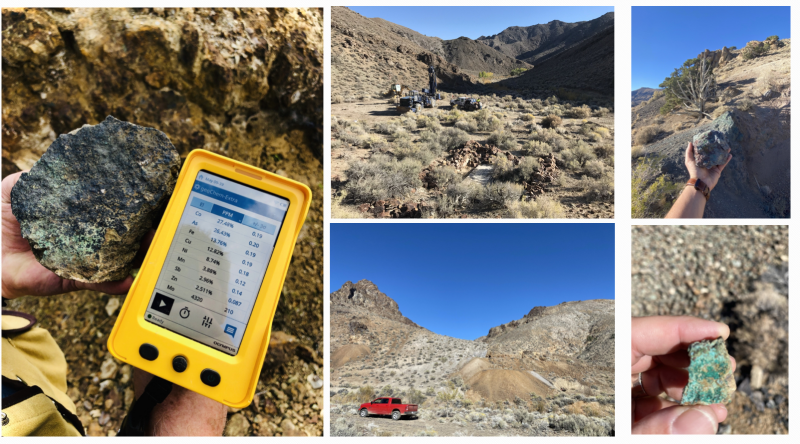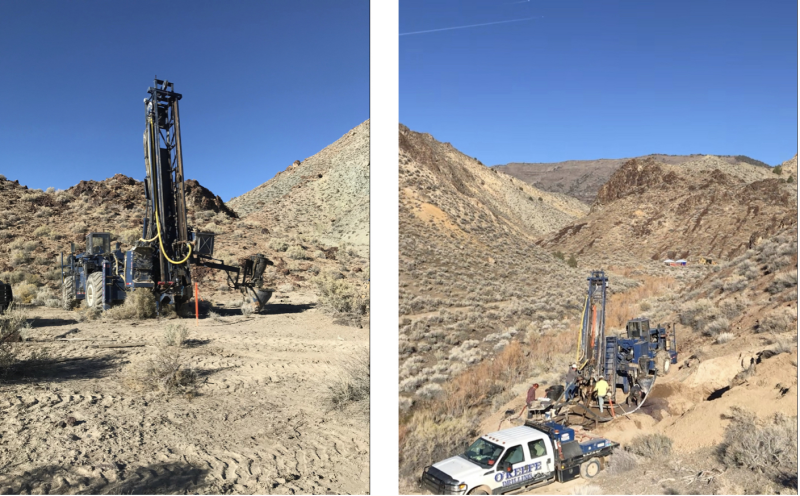Archive
Global Energy Metals Summarizes Activities at the Lovelock and Treasure Box Projects and Outlines Next Steps in Light of Positive Results
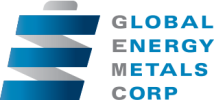 | |||||||||
 |  | ||||||||
Vancouver, BC - TheNewswire - January 31, 2023 - Global Energy Metals Corporation (TSXV:GEMC) | (OTC:GBLEF) | (FSE:5GE1) (“Global Energy Metals”, the “Company” and/or “GEMC”), a multi-jurisdictional, multi-commodity critical mineral exploration and development company focused on growth-oriented battery metal projects supporting the global transition to clean energy, is pleased to provide a recap of its activities, including a summary of the positive results from multiple exploration programs carried out in 2022 at its Lovelock and Treasure Box projects (“Lovelock”, “Treasure Box” and/or the “Projects”) located in the Stillwater Range in Nevada, USA along with the Company’s plans in light of positive results.
Mitchell Smith, CEO & Director comments:
"We continue to be impressed by the results and progress at both the Lovelock and Treasure Box projects. From the series of exploration programs and interpretive studies conducted in 2022 we are confident in the foundation that has been set and with recommendations made, look forward to realizing the potential of these exciting copper, nickel cobalt projects in mining friendly Nevada."
Image 1. Compilation of images taken from project reconnaissance trips to the Lovelock and Treasure Box projects.
The Lovelock project is a past-producing high-grade cobalt, copper, nickel project that had not undergone exploration using modern technique until GEMC initiated activities in 2019. Since that time GEMC has been active on the project conducting various types of exploration including the use of artificial intelligence (“AI”) to identify new target areas. In the first ever drill program at Lovelock, elevated values of cobalt, nickel and copper were intercepted in three of the holes which targeted possible mineralization beneath historical mine workings.
The Treasure Box project hosts mine workings from limited copper production. A historical diamond drill hole drilled at the Treasure Box by the Boyer-Nevada Copper Company (circa 1910) reportedly intersected 1.52% copper over 85 feet (25.9 metres) with mineralization beginning at surface. Global Energy holds an 85% interest in the Projects through its wholly owned subsidiary, US Battery Metals Corp. Click on headings below for more details.
Sampling Program at Treasure Box Including Copper Assays up to 36.4% Copper
-
Prospecting and sampling program for the Project now complete
-
Assay results from the program highlight the prevalence of copper mineralization, with localized high-grade silver.
-
Assays included 36.4% Copper, 176g/t Silver and 1.325g/t Gold
-
••Confirmed mineralization in areas identified by Earthlabs as priority targets
-
••Results of this initial field work at the Property are encouraging and additional work is warranted.
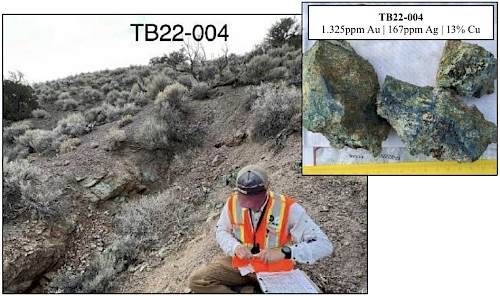
Image 2. Historical Prospect Pit - Collection site of TB22-004 with visible Cu oxide development along fractures and veins, including malachite and azurite within altered mafic basalt unit. Sample assayed 13% Cu, 167g/t Ag and 1.325g/t Au.
Sampling Program at Lovelock with Strong Copper, Nickel and Cobalt Assay Values
-
Initial AI assessment resulted in discovery of several new areas.
-
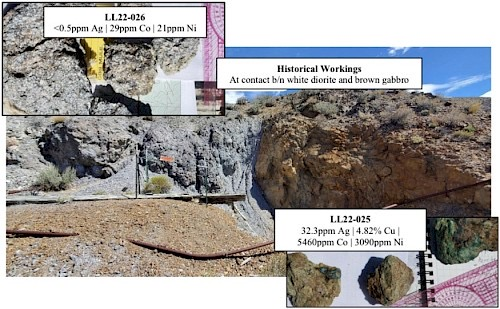
Successfully identified strong nickel, cobalt, copper and silver showings within the property boundaries.
Successfully identified strong nickel, cobalt, copper and silver showings within the property boundaries. -
Sampled target areas produced promising results with new areas identified.
-
Results of this initial field work at the Project are encouraging and additional work is warranted.
Image 3: Historical working including adit and small pit located along the contact between the white HMC diorite and the brown, iron-oxidized HMC gabbro. Samples assayed included LL22-025 with 4.82% Cu, 0.546% Co, 0.309% Ni and 32.3g/t Ag.
-
Earthlabs was engaged to apply their proprietary machine learning applications and geoscience expertise to assist the Company in expanding discoveries and identifying new high-priority target areas.
-
Earthlab's AI and geological interpretation highlights cobalt, nickel, copper potential at GEMC's Nevada based projects;
-
A total of 30 exploration targets have been identified, 15 on the Lovelock Project and 15 targets identified on the Treasure Box Project;
-
In preparation for field work, Earthlabs provided a map of probable target zones, resulting from the analysis allowing for time-and cost-efficient field exploration; and
-
The Company engaged Dahrouge Geological to conduct a field program to field check the exploration target areas presented to help confirm lithologies and validate and prioritize the targets.
-
The Dahrouge led programs focused on developing new targets on the Lovelock project and further define high potential historical prospects from the target pipeline compilation on the Treasure Box project.
Images 4 & 5. AI & Machine Learning targeting map showing the 30 exploration targets identified at the Lovelock and Treasure Box projects.
First-Ever Drill Program at Lovelock
-
The Company intersected nickel, copper and cobalt mineralization during its Phase One drilling at the at the Lovelock Cobalt-Nickel-Copper project
-
Continued to improve understanding of the copper, cobalt and nickel mineralization in the extensive IOCG system as a result of the drilling program.
-
Target areas tested on this limited initial drill campaign intersected mineralization of the key battery metals targeted which will require follow-up testing, including excellent results from the areas adjacent to and under the historical mine.
-
In addition, there are still multiple areas yet to be tested, and through the newly entered partnership with Earthlabs, GEMC prioritized new targets for a second phase drill program.
-
Importantly, elevated values of cobalt, nickel and copper were intercepted in three of the holes which targeted possible mineralization beneath the historical mine workings.
-
Surface sampling, mapping and geophysical surveying identified a number of potential mineralized areas on the property.
Drill Permit Approval and Proposed Treasure Box Drill Program
-
GEMC received approval from the US Bureau of Land Management (the “BLM”) for its proposed exploration and drill plan under a Notice of Intent (“NOI”) at Treasure Box.
-
The proposed initial drilling program at Treasure Box includes up to fourteen (14) vertical drill holes from thirteen (14) different locations.
-
Planned drill hole lengths range from 350 feet (107 metres) to 500 feet (152 metres) for total drilling anticipated to be 6,550 feet (2,000 meters).
-
The Company is currently seeking a qualified and experienced drilling company to provide diamond core drilling services for an initial drilling campaign on a part of the claim block.
-
A valid USBLM NOI covers the project area and allows for the described drilling activities.
Images 6 & 7. Drilling first-ever holes at the prospective cobalt, nickel, copper Lovelock project in Nevada.
SJ Geophysics Data Interpretation of the Projects
-
SJ Geophysics reinterpreted historical drilling and mining data related to the Company’s copper-cobalt Treasure Box project and reviewed and incorporated historical geological data collected from previous operators spanning over a century in order to support exploration programs at the Project.
-
In addition, SJ evaluated the drilling at the Lovelock Project from a geophysical data perspective.
-
SJ performed the initial IP survey and integrated the results of the airborne magnetic survey and then made recommendations relative to drill hole location and orientation.
-
The drill program at Lovelock was directed at several target areas within the property: the Lovelock Mine Zone and targets generated through surface sampling, mapping and a high-power induced polarisation (“IP”) ground geophysical survey, which were subsequently prioritized by a follow-up surface geochemical program and airborne magnetic survey.
-
Several of these anomalies were targeted for the initial drilling program in 2021 at Lovelock.
Lovelock Recommendations
The results of this initial field work at the Lovelock Property are encouraging and additional exploration is recommended. Roughly half of the sampled Goldspot target areas produced promising results. The next phase of work should include detailed geologic and structural mapping over the Property’s extent, and a systematic rock and soil sampling program across more focused target areas delineated during this program and results derived during geologic and structural mapping.
The 2022 sampling of the GEMC Lovelock Property was successful in identifying existing nickel, cobalt, copper and silver showings within the property boundaries, as well as identifying potential mineralized trends along proposed faults and lithologic contacts. The fieldwork focused on identifying mineralized host rocks and delineating potential mineralized structures. Although fieldwork produced some strong results, a large part of the property remains to be prospected. It is recommended that future field work include detailed geologic mapping and accurate structural measurements of this proposed structure, with further sampling focused along the strike length of the faulting in that area.
It is recommended that future work continue to delineate the extent of mineralization along structures within the HMC intrusives. Areas with notable oxidation and strong alteration should be carefully mapped, and the ore-fluid containing structures identified. Sampling along the strike length of these structures throughout the Property would be the next phase of field exploration and sampling.
The northeastern extent of the property, especially along the strike length of the mineralized fault zone, will need to be visited and sampled.
Most of the work conducted in the 2022 field program was focused on historical workings and on the delineated structure-contact targets identified by Earthabs. It is recommended additional mapping and prospecting is conducted within and beyond the limits of the current claim boundary along strike of the main structure, in order to better understand the controls on mineralization. Once surface extents and detailed mapping are completed and assessed, the next phase would be to develop a drill program to test the depth of mineralization at the unconformity contact, explore for mineralization not exposed at surface, and develop a structural framework of the mineralized fault systems.
Treasure Box Recommendations
The results of this initial field work at the Property are encouraging and additional work is warranted. The next phase of exploration work should include detailed geologic and structural mapping over the Property’s extent, and systematic rock and soil sampling program across more focused target areas delineated during this program and results derived during geologic and structural mapping.
Structures in the area appear to have general northwest-southeast to north-south trends, which have locally influenced several historical Cu-Ag-Au mineralized showings. It is recommended that future work continue to delineate the extent of mineralization along the unconformity between the Jurassic mafics and Tertiary rhyolite units. Zones with notable oxidation and strong alteration should be carefully mapped, and the ore-fluid containing structures identified. Sampling along the strike length of these structures throughout the Property would be the final phase of field exploration.
The southern extent of the Property will need to be sampled and mapped, in order to correlate the relationship between mineralization and the intruding HMC gabbros and diorites.
There is evidence for other mineralized zones outside the claim property boundary, particularly concentrated along the paleosurface between the Jmv and Tv. Most of the work conducted in the 2022 field program was focused on the historic workings and on the delineated structure-contact targets identified by Goldspot. It is recommended that additional mapping and prospecting is conducted within and beyond the limits of the current claim boundary along strike of the main structure, to better understand the controls on mineralization. Once surface extents and detailed mapping are completed and assessed, the next phase would be to develop a drill program to test the depth of mineralization at the unconformity contact, explore for mineralization not exposed at surface, and develop a structural framework of the mineralized fault systems.
About Lovelock
The Property currently consists of 81 unpatented lode claims in the Cottonwood Canyon area of the Stillwater Range totaling approximately 1,586 acres (642 hectares). It was discovered by George Lovelock and Charles Bell about 1880. According to U.S. Government annual reports, the Lovelock Mine saw limited production of nickel, copper and cobalt beginning in 1883. The primary cobalt mineral was identified as “cobaltite”. The general average of the 200 tons shipped in 1886 averaged 14 percent cobalt and 12 percent nickel. The mine operated from 1883 to 1890 to the 100 foot level, reporting 500 tons of cobalt and nickel mineralized material shipped to England for processing. After intermittent production, an English company attempted smelting on site in 1898 but little or no production was made (Source: “Mineral Resources of the United States for 1885”, 1886). No further production from the Lovelock Mine is known for well over a century providing GEMC an excellent opportunity to unlock the potential value of the deposit through exploration work. In a recent drill program at Lovelock by GEMC, elevated values of cobalt, nickel and copper were intercepted in three of the holes which targeted possible mineralization beneath the historical mine workings.
About Treasure Box
Treasure Box hosts mine workings from limited copper production, which occurred until early into the 20th century. A historical diamond drill hole (circa 1910) drilled at the Treasure Box by the Boyer-Nevada Copper Company reportedly intersected 1.52% copper over 85 feet (25.9 metres) with mineralization beginning at surface. A reverse circulation hole drilled on the Treasure Box by Utah International in 1976 returned 1.55% copper over 40 feet (12.2 metres) from a depth of 85 to 125 feet (25.9 to 38.1 metres), and the hole was stopped in chalcopyrite mineralization. The core Treasure Box claims were held continuously for over 20 years by a private company but were relinquished in September 2017, leading to their acquisition by Nevada Sunrise. GEMC received approval from the US Bureau of Land Management (the “BLM”) for a proposed exploration and drill plan at the Treasure Box project that includes up to thirteen (13) vertical drill holes from thirteen (13) different locations. Planned drill hole lengths range from 350 feet (107 metres) to 500 feet (152 metres). Total drilling is anticipated to be 5,850 feet (1,784 meters), with a minimum drilling length of three (3) drill holes totaling 1,350 feet (412 metres). Depending on findings, individual drill hole lengths could be extended by 30 to 50 feet (10 to 15 metres) as determined by the company’s on-site representative. The targeted prospects have been identified by Global Energy Metals through a systematic exploration program over the past several months that has included an airborne magnetic survey, reinterpretation of historical Induced Polarization (IP) data, detailed mapping and desktop review of historical data including past drilling.
Qualified Person
Mr. Paul Sarjeant, P. Geo., is the qualified person for this release as defined by National Instrument 43-101 - Standards of Disclosure for Mineral Projects. He is a shareholder and Director of the Company.
Global Energy Metals Corporation
(TSXV:GEMC | OTCQB:GBLEF | FSE:5GE1)
Global Energy Metals Corp. offers investment exposure to the growing rechargeable battery and electric vehicle market by building a diversified global portfolio of exploration and growth-stage battery mineral assets.
Global Energy Metals recognizes that the proliferation and growth of the electrified economy in the coming decades is underpinned by the availability of battery metals, including cobalt, nickel, copper, lithium and other raw materials. To be part of the solution and respond to this electrification movement, Global Energy Metals has taken a ‘consolidate, partner and invest’ approach and in doing so have assembled and are advancing a portfolio of strategically significant investments in battery metal resources.
As demonstrated with the Company’s current copper, nickel and cobalt projects in Canada, Australia, Norway and the United States, GEMC is investing-in, exploring and developing prospective, scaleable assets in established mining and processing jurisdictions in close proximity to end-use markets. Global Energy Metals is targeting projects with low logistics and processing risks, so that they can be fast tracked to enter the supply chain in this cycle. The Company is also collaborating with industry peers to strengthen its exposure to these critical commodities and the associated technologies required for a cleaner future.
Securing exposure to these critical minerals powering the eMobility revolution is a generational investment opportunity. Global Energy Metals believes Now is the Time to be part of this electrification movement.
For Further Information:
Global Energy Metals Corporation
#1501-128 West Pender Street
Vancouver, BC, V6B 1R8
Email: info@globalenergymetals.com
t. + 1 (604) 688-4219
www.globalenergymetals.com
Twitter: @EnergyMetals | @USBatteryMetals | @ElementMinerals
Cautionary Statement on Forward-Looking Information:
Certain information in this release may constitute forward-looking statements under applicable securities laws and necessarily involve risks associated with regulatory approvals and timelines. Although Global Energy Metals believes the expectations expressed in such forward-looking statements are based on reasonable assumptions, such statements are not guarantees of future performance and actual results or developments may differ materially from those in the forward-looking statements. Except as required by law, the Company undertakes no obligation to update these forward-looking statements in the event that management’s beliefs, estimates or opinions, or other factors, should change.
GEMC’s operations could be significantly adversely affected by the effects of a widespread global outbreak of a contagious disease, including the recent outbreak of illness caused by COVID-19. It is not possible to accurately predict the impact COVID-19 will have on operations and the ability of others to meet their obligations, including uncertainties relating to the ultimate geographic spread of the virus, the severity of the disease, the duration of the outbreak, and the length of travel and quarantine restrictions imposed by governments of affected countries. In addition, a significant outbreak of contagious diseases in the human population could result in a widespread health crisis that could adversely affect the economies and financial markets of many countries, resulting in an economic downturn that could further affect operations and the ability to finance its operations.
For more information on Global Energy and the risks and challenges of their businesses, investors should review the filings that are available at www.sedar.com.
Neither TSX Venture Exchange nor its Regulation Services Provider (as that term is defined in the policies of the TSX Venture Exchange) accepts responsibility for the adequacy or accuracy of this release.
We seek safe harbour.
